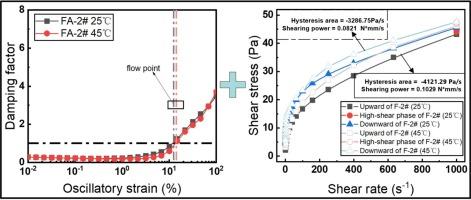多类型纳米颗粒对短链碳氟化合物与碳氢表面活性剂混合物泡沫热流变性能的影响
IF 4.6
2区 工程技术
Q2 ENGINEERING, CHEMICAL
引用次数: 0
摘要
虽然纳米颗粒(NPs)可以增强消防泡沫的流变性能,但不同类型的NPs对泡沫热流变性能的影响尚不清楚。采用短链碳氟化合物和碳氢化合物表面活性剂,以及3种NPs (SiO2、Al(OH)3和β-Al2O3)制备泡沫材料。分析了NPs与表面活性剂的相互作用及其对泡沫性能、泡沫稳定性和泡沫热流变性能的影响。结果表明,NPs可以与表面活性剂分子形成聚集体,从而影响泡沫分散体的表面张力、pH值、电导率、zeta电位、粘弹性和粘度。NPs可以使泡沫分散体的初始泡沫高度从340 mL降低到250 ~ 260 mL,发泡能力明显降低。这三种NPs均能显著延缓泡沫排水,增强泡沫稳定性。在45°C时,NPs可以降低泡沫粘度和粘弹性。在45°C时,所有泡沫的触变性都有不同的趋势,其中Al(OH)3 NPs泡沫的触变性结构恢复效果最好。含Al(OH) 3nps的泡沫在45℃时的迟滞行为有所降低,而含SiO2和β-Al2O3的泡沫则有所增加。总的来说,这三种NPs都能增强泡沫稳定性和泡沫热流变性能,其中Al(OH)3表现出最强的能力。本研究可为NPs稳定消防泡沫的研制提供理论支持。本文章由计算机程序翻译,如有差异,请以英文原文为准。

Influence of multi-type nanoparticles on the foam thermo-rheological properties of mixtures of short-chain fluorocarbons and hydrocarbon surfactants
While nanoparticles (NPs) are known to enhance the rheological properties of firefighting foams, the impact of different NPs types on the foam thermo-rheological properties has remained unclear. Short-chain fluorocarbon and hydrocarbon surfactants, and three types of NPs (SiO2, Al(OH)3, and β-Al2O3) were used to prepare the foams. The interactions between NPs and surfactants, as well as their effects on foaming ability, foam stability, and foam thermo-rheological properties, were analyzed. Results indicated that NPs can form aggregates with surfactant molecules, thereby affecting surface tension, pH value, conductivity, zeta potential, viscoelasticity, and viscosity of foam dispersion. NPs can reduce the initial foam height of the foam dispersion from 340 mL to 250–260 mL, and significantly decrease the foaming ability. All three NPs could significantly delay foam drainage and enhance foam stability. At 45 °C, the NPs can decrease foam viscosity and viscoelasticity. The thixotropy of all foams at 45 °C showed different trends, and the foam with Al(OH)3 NPs showed the best thixotropic structure recovery. Hysteresis behavior at 45 °C of the foam with Al(OH)3 NPs decreased, but increased in the foam containing SiO2 and β-Al2O3. In general, all three NPs could enhance the foam stability and foam thermo-rheological properties, with Al(OH)3 demonstrating the strongest capability. This study can provide theoretical support for the development of firefighting foam stabilized by NPs.
求助全文
通过发布文献求助,成功后即可免费获取论文全文。
去求助
来源期刊

Powder Technology
工程技术-工程:化工
CiteScore
9.90
自引率
15.40%
发文量
1047
审稿时长
46 days
期刊介绍:
Powder Technology is an International Journal on the Science and Technology of Wet and Dry Particulate Systems. Powder Technology publishes papers on all aspects of the formation of particles and their characterisation and on the study of systems containing particulate solids. No limitation is imposed on the size of the particles, which may range from nanometre scale, as in pigments or aerosols, to that of mined or quarried materials. The following list of topics is not intended to be comprehensive, but rather to indicate typical subjects which fall within the scope of the journal's interests:
Formation and synthesis of particles by precipitation and other methods.
Modification of particles by agglomeration, coating, comminution and attrition.
Characterisation of the size, shape, surface area, pore structure and strength of particles and agglomerates (including the origins and effects of inter particle forces).
Packing, failure, flow and permeability of assemblies of particles.
Particle-particle interactions and suspension rheology.
Handling and processing operations such as slurry flow, fluidization, pneumatic conveying.
Interactions between particles and their environment, including delivery of particulate products to the body.
Applications of particle technology in production of pharmaceuticals, chemicals, foods, pigments, structural, and functional materials and in environmental and energy related matters.
For materials-oriented contributions we are looking for articles revealing the effect of particle/powder characteristics (size, morphology and composition, in that order) on material performance or functionality and, ideally, comparison to any industrial standard.
 求助内容:
求助内容: 应助结果提醒方式:
应助结果提醒方式:


